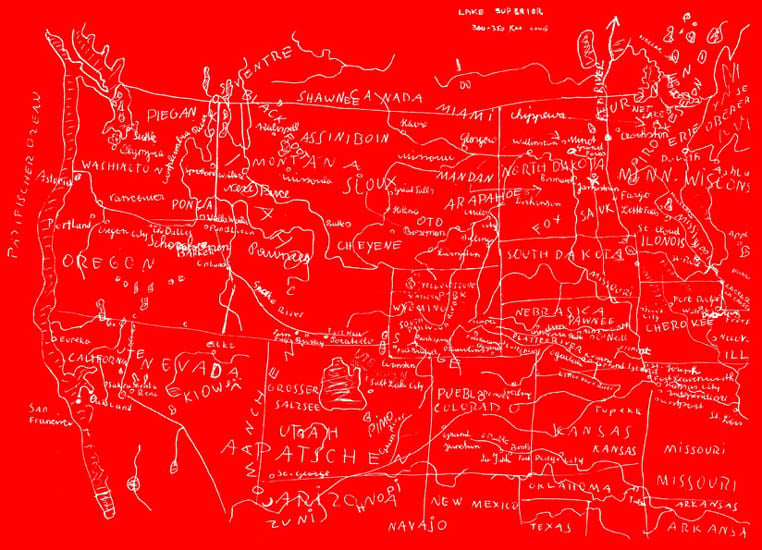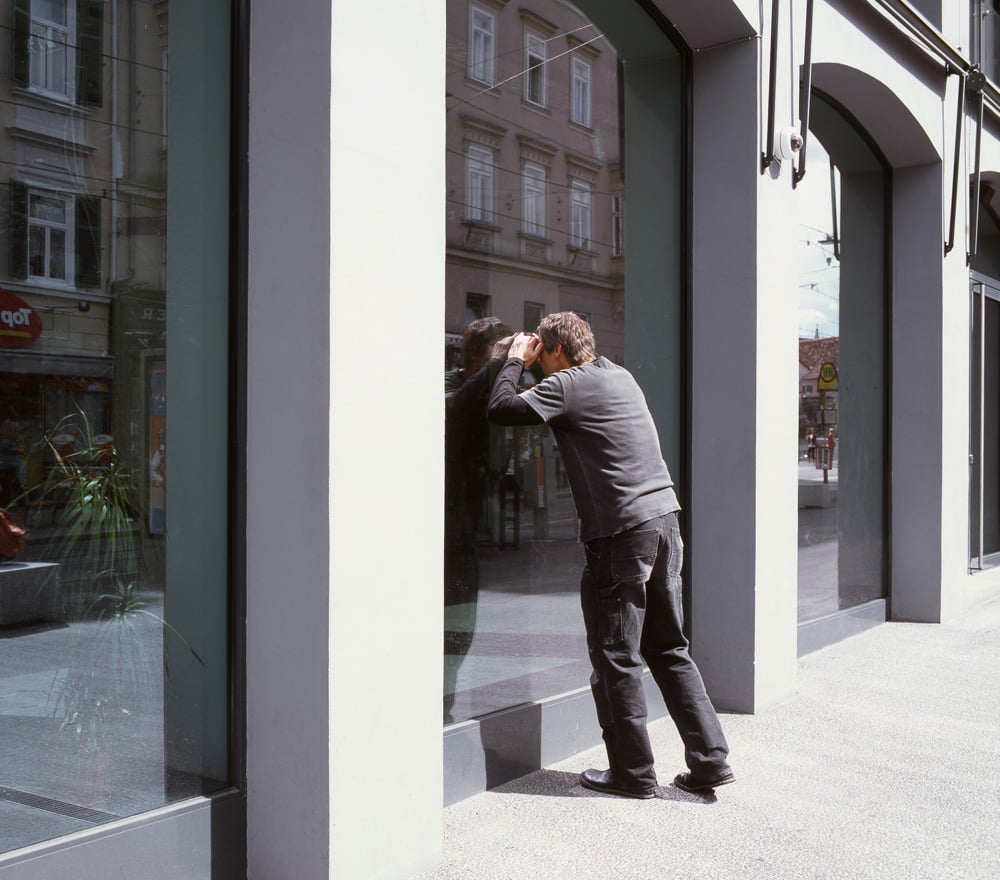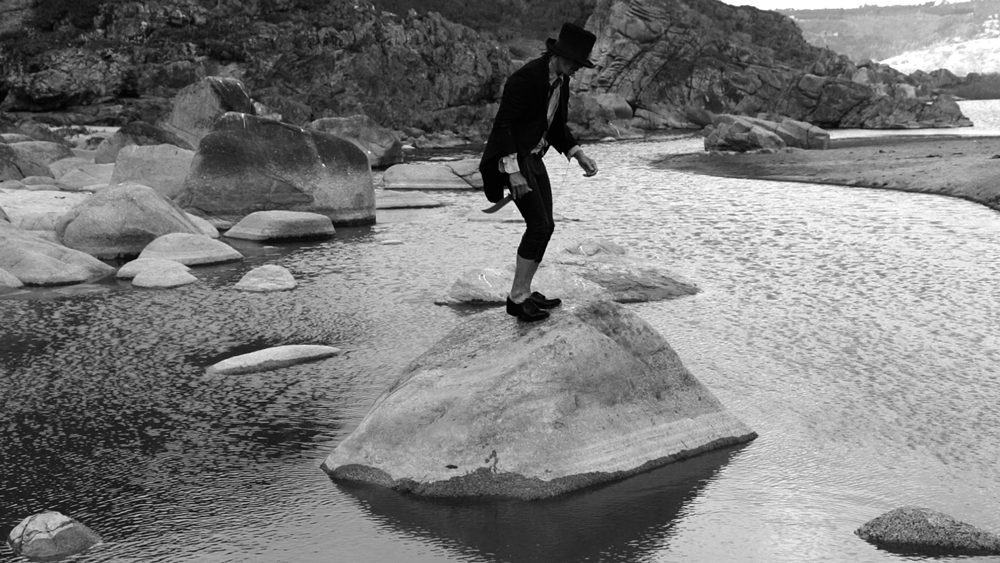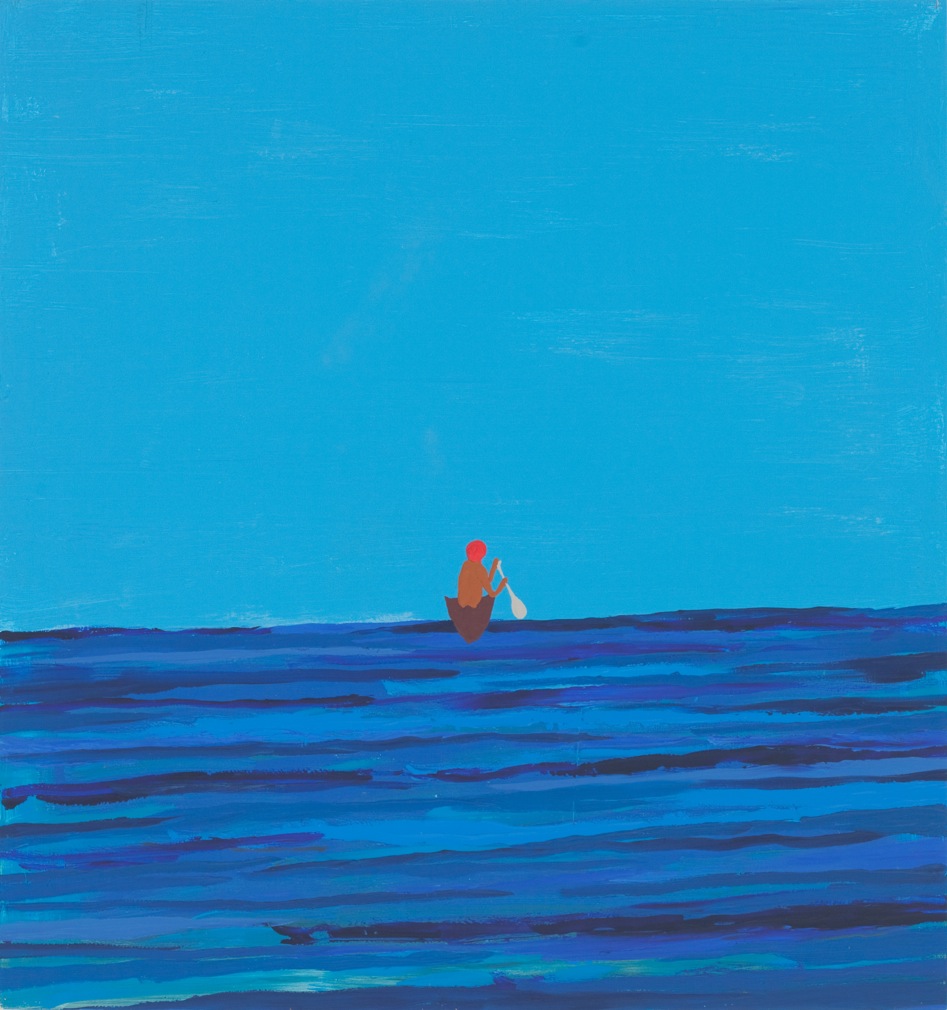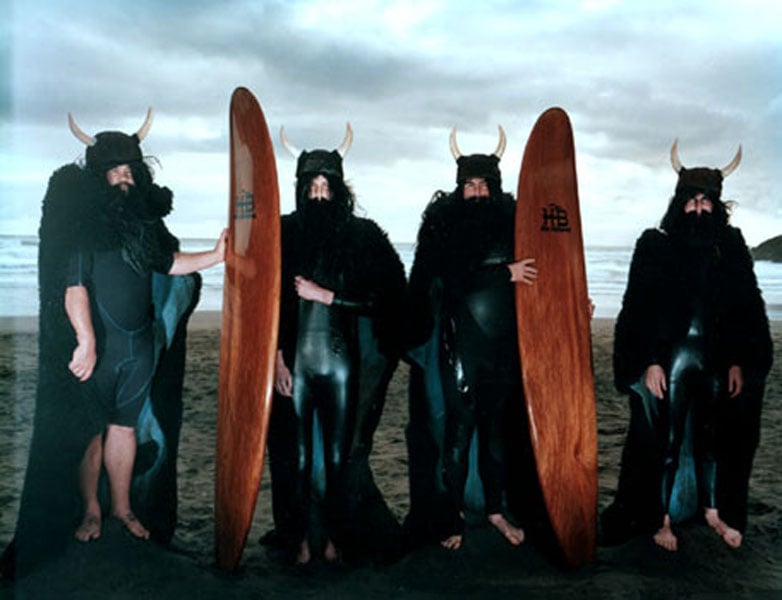
© » KADIST
Jean-Luc Moulène
It rains, Paris, 1st July 2000 , which could be the refrain of a song, is the title of a photograph of a minimal moment, the vision of a Parisian pedestrian, a cut flower lying on the pavement covered in rain drops. Is this moment captured by chance or a mise en scène? There is a sort of hiatus in the image; the planes – motif and background – connect nature in full bloom, pure, fragile, ephemeral with the grey weighty tarmac.

© » KADIST
Chris Johanson
Apartment on Cardboard (2000) is an exterior view of an abstracted apartment building. Viewers unwittingly become voyeurs, peering through the rectangles that stand for windows and observing the residents therein, who ponder questions both mundane and existential: “Where is Ron now?” and “What have I become?” The queries and characters are treated democratically—not judged, praised, or subjected to hierarchy. While their thoughts are specific, the painting captures a universal urban activity: looking across to the building next door and wondering about its residents, all the while knowing that they have probably looked over and wondered about us, as well.
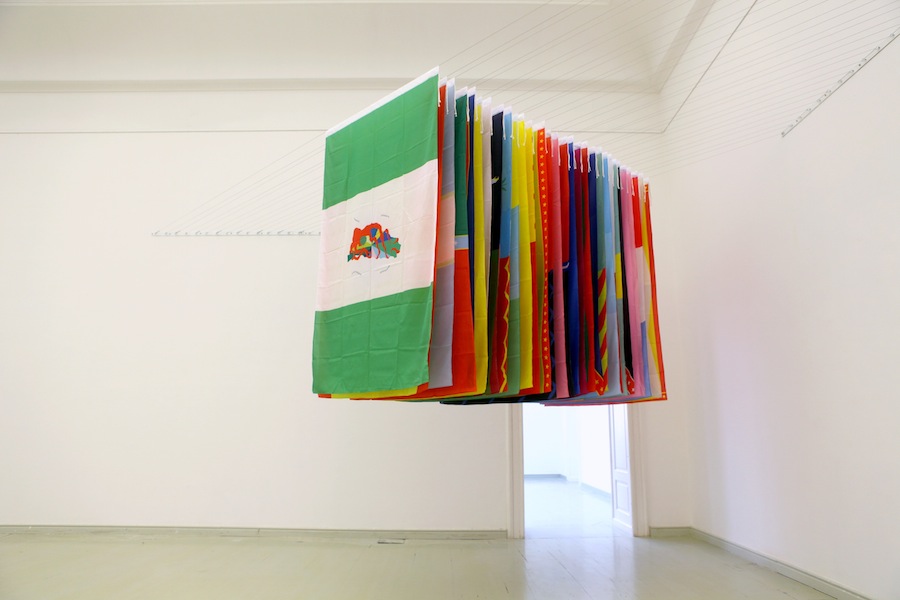
© » KADIST
Jao Chia-En
30 Proposals of Flag explores the relationships between signs, meanings, aesthetics, and nations. The artwork consists of 30 flags layered together and hanging from the ceiling. Each flag is illustrated with Jao’s rendition of a possible coat of arms derived from Taiwan’s economic and political history.

© » KADIST
Joscelyn Gardner
Drawing & Print (Drawing & Print)
Creole Portraits III alludes to the 18th century practice by slave women on Caribbean plantations of using tropical plants as natural abortifacients. As an act of political resistance against their exploitation as “breeders” of new slaves and to protest the inhumanity of slavery, some slave women chose to either abort or kill their offspring. Armed with practical knowledge passed on orally from their African ancestors and/or Amerindian counterparts, enslaved Creole women collected the seeds, bark, flowers, sap, and roots from various plants which allowed them to secretly put an end to their pregnancies.
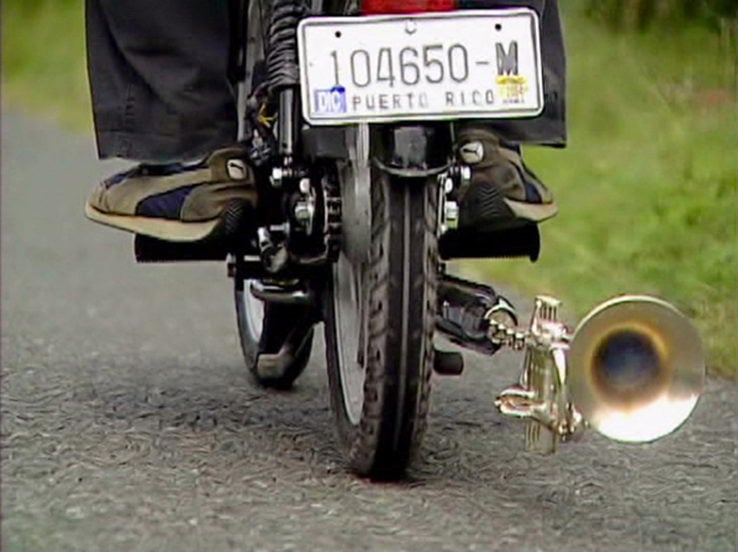
© » KADIST
Allora & Calzadilla
Vieques is an island off the mainland of Puerto Rico used by the U. S Navy and NATO forces as military testing ground as from the 1940s. Civil disobedience and active protest movements initiated by local inhabitants and an international support network led to the end of the bombings and progressive demilitarization in 2002.

© » KADIST
Peter Friedl
Peter Friedl’s projects place aesthetic questions within an expanded field that takes into account the social, political and philosophical context. This textile piece quotes and diverts a flag with a red background and the central star of the Kurdistan National Liberation Front (ERNK, a military organization linked to PKK, founded in 1985 and disbanded in 2000), and not the national flag of Kurdistan. The artist became interested as from 1994, when the town of Lice was destroyed by the Turkish army and the PKK was expelled from Germany.

© » KADIST
Allora & Calzadilla
This series of photographs is part of the body of work Allora & Calzadilla made regarding the situation in Vieques, an island off the mainland of Puerto Rico used for the 60 years by the U. S Military and NATO forces to practice military bombing exercises. In 2000, they began a collaboration with the local activists to make the campaign more visible.

© » KADIST
Annie Pootoogook
Annie Pootoogook created COMPOSITION (EEGYVUDLUK DRINKING TEA) at a pivotal moment in her career. The drawing depicts her father Eegyvudluk Pootoogook, an Inuk printmaker and stone sculptor who died in 2000. Kin and kinship figure prominently in the artist’s work: Annie was the daughter of Napachie Pootoogook, a skilled draftswoman, and the granddaughter of renowned artist Pitseolak Ashoona.

© » KADIST
Marcelo Cidade
Marcelo Cidade interrogates the city, architecture and urban planning. This architectonic drawing proposes modular possibilities, adaptable variations based on the form of the concrete block (a material which is often actually integrated in his practice). The “re-definition” announced in the title is in construction, in process, under development, in flux.

© » KADIST
Trisha Donnelly
Untitled is a black-and-white photograph of a wave just before it breaks as seen from the distance of an overlook. Donnelly’s interest in the waveform–visually, aurally, and perceptually–is made manifest in works across multiple media, including photography, drawing, video, sculpture, and performance.
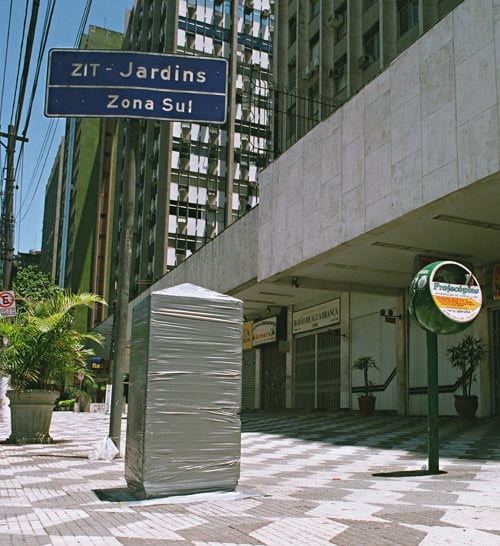
© » KADIST
Marcelo Cidade
This series of photographs reflects Marcelo Cidade’s incessant walks or drifting through the city and his chance encounters with a certain street poetry like the Surrealists or Situationists before him. He captures incongruities or everyday simplicity and highlights their suggestive power. The composition and framing of these interventions specially emphasizes the object of interest and the humor of the context.

© » KADIST
Roman Ondak
Drawing & Print (Drawing & Print)
As the caption purposely admits, these drawings were made by friends of Ondák’s at home in Slovakia asked to interpret places he has journeyed to. The description of the blond artist wearing the same outfit and bag in places of transit like airports, stations or streets are faithful in straightforward (verging on naïve) styles. His own skill as artist is displaced and delegated to others with no particular gift in draftsmanship.

© » KADIST
Allora & Calzadilla
This series of photographs is part of the body of work Allora & Calzadilla made regarding the situation in Vieques, an island off the mainland of Puerto Rico used for the 60 years by the U. S Military and NATO forces to practice military bombing exercises. In 2000, they began a collaboration with the local activists to make the campaign more visible.

© » KADIST
Piero Golia
Golia’s Untitled 3 is an installation in which a mechanical device is programmed to shoot clay pigeons that are thrown up in front of a white wall. More than a simple reference to the sport, the work has the disconcerting effect of creating a danger zone in the gallery space. The reference to direct aggression or violence is reinforced by the piece’s rapid pace.
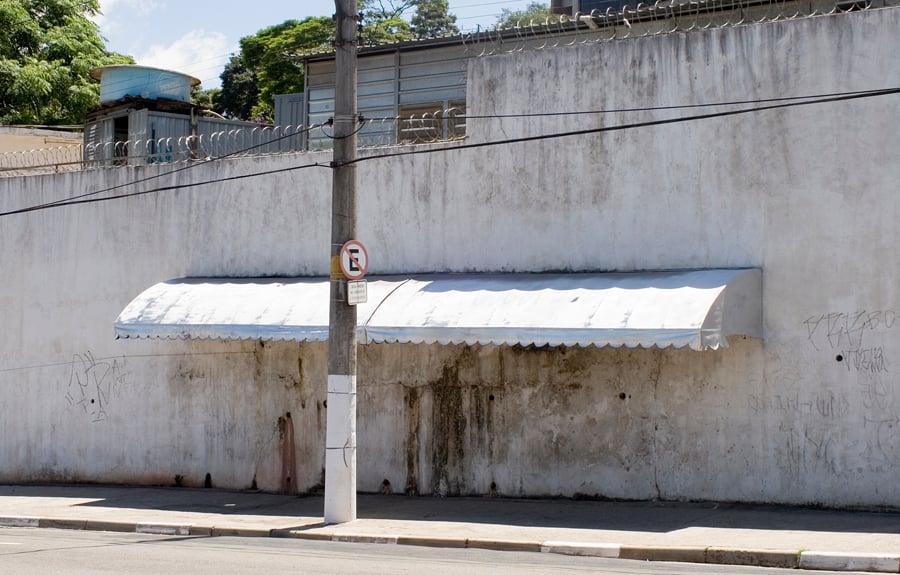
© » KADIST
Marcelo Cidade
This series of photographs reflects Marcelo Cidade’s incessant walks or drifting through the city and his chance encounters with a certain street poetry like the Surrealists or Situationists before him. He captures incongruities or everyday simplicity and highlights their suggestive power. The composition and framing of these interventions specially emphasizes the object of interest and the humor of the context.
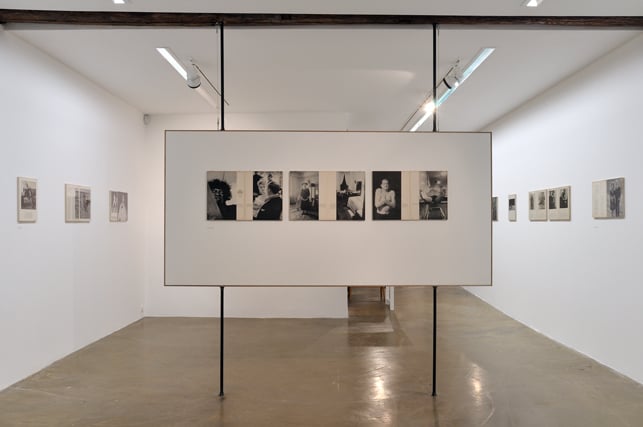
© » KADIST
Pierre Leguillon
End of 2008, Pierre Leguillon presented at KADIST, Paris the first retrospective of the works of Diane Arbus (1923-1971) organized in France since 1980, bringing together all the images commissioned to the New York photographer by the Anglo-American press in the 1960s. This exhibition, destined to tour in various locations, presents the original pages of the magazines, including “Harper’s Bazaar”, “Esquire”, “Nova” and “The Sunday Times Magazine”. As Pierre Leguillon states: “The mythology surrounding Diane Arbus’ character is willingly set aside to offer a more neutral point of view on a more unfamiliar part of her work, although it was mass-distributed.” Many of the characters portrayed in these commissioned works seem less sensational at first glance than the “freaks” that made Diane Arbus’ work so famous, since the retrospective MOMA organized in 1973 in New York, two years after her suicide.

© » KADIST
Diana Fonseca Quiñones
In Los amantes (The lovers) Diana Fonseca Quiñones uses simple, commonplace objects and experiences that she derives from daily life to develop narratives that mix reality and fiction. Drawing on seemingly everyday moments, such as lighting a match, Quiñones creates poetic metaphors that cleverly comment on broader social issues, as well as politics, and universal human desires. In her profound work Los amantes, the humblest of materials, a pair of burning matches, becomes a parable for the sharing, longing, restraint, and death that everyone faces in life.

© » KADIST
Bruno Serralongue
The half-length portrait of Joe Shirley presents a man with a great presence, wearing several items that point to ancestral Native American culture. In this photograph, which is relatively poor in information, the projection screen in the background acts as a clue about the event: Bruno Serralongue went to the second phase of the ‘Sommet Mondial sur la Société de l’Information’ (or SMSI, World Summit on Information Society, in Tunis in November 2005). This portrait echoes another picture in the same series (Native Peoples Claim Their Right to Participate in the Information Society) in which Joe Shirley is just a silhouette amongst the speakers, whereas here he occupies the entire frame.
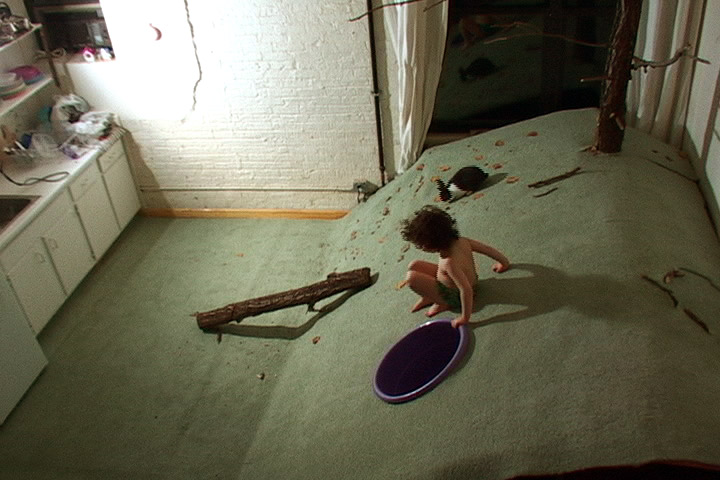
© » KADIST
Guy Ben-Ner
Wild Boy is the story of the education of Amir, the artist’s son. Ben-Ner plays the educator’s part, trying to domesticate the child. Using the metaphor of the wild child is Ben-Ner’s homage to this recurring theme in literature and cinema: from Edgar Rice Burroughs’ « Tarzan » to Truffaut’s « L’enfant sauvage », and Rudyard Kipling’s « Jungle book ».

© » KADIST
Alejandro Marré
Typical Weapons is a series of sculptural interventions where Alejandro Marre transforms traditional Guatemalan craft objects usually sold as souvenirs into weapons. Wooden flutes, hacky sacks, and musical instruments are woven with rope to appear as nunchucks, slingshots, and other forms of armament. Designed to be exhibited as objects from an archaeological museum, the previously innocuous representations of Guatemalan popular culture acquire darker meanings as they come to symbolize the brutality and extreme violence that now mark the country.
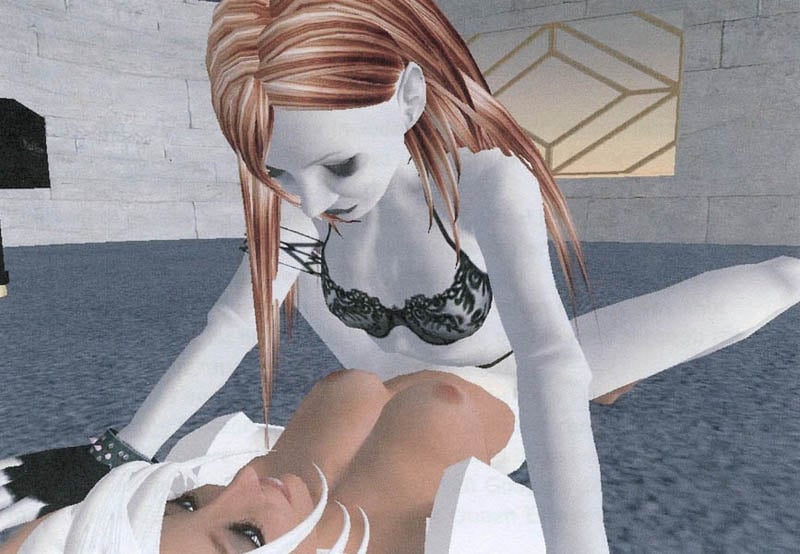
© » KADIST
Miri Segal
The work BRB is a 30 min. journey in the new game world of Second Life (“SL”). Consistent with Segal’s work with the projected image, this video was shot using a virtual in-world camera, with the footage later being transformed by a software custom designed by the artist.

© » KADIST
Thomas Kilpper
Drawing & Print (Drawing & Print)
These two images come from the series called “State of Control” which Kilpper made in the building formerly occupied by the Stasi in Berlin. As a symbol of the past there could be none more powerful than this. By carving into its floor, Kilpper laid bare its history by making images of its occupants and political figures associated with that period of history.

© » KADIST
Thomas Kilpper
Drawing & Print (Drawing & Print)
These two images come from the series called “State of Control” which Kilpper made in the building formerly occupied by the Stasi in Berlin. As a symbol of the past there could be none more powerful than this. By carving into its floor, Kilpper laid bare its history by making images of its occupants and political figures associated with that period of history.

© » KADIST
Koki Tanaka
Walking Through is one of a series of videos—sometimes humorous, often absurd—that record the artist’s performative interactions with objects in a particular site. Here, Tanaka has spread out various objects he collected throughout the city of Guangzhou. By fiddling with a window frame, water buckets, plastic bags, cardboard, soda bottles, and many other things, Tanaka creates fragile, temporary sculptures.

© » KADIST
Mohamed Bourouissa
The film called Temps Mort (Dead Time or Time Out) presents an exchange of short video footage assembled into one final edit. Remotely driven footage of daily life in prison, the banality of a sink, of a plant or a plate of pasta are offtset against scenes of life outside, in the streets of Paris, a night of love or seascapes. The dialogue between the inmate and the artist occurs by text messages and captures this exceptional situation of exchange, sharing et perhaps dependence.

© » KADIST
Mohamed Bourouissa
Temps Mort is the result of one year of mobile phone exchanges of still images and videos between the artist and a person incarcerated in prison. Mohamed Bourouissa directs the scenes to be reconstructed inside the prison from a distance. With sketches and instructions, he indicates in detail the sort of shots he would like to receive.

© » KADIST
Nagendra Gurung
Chalis Katesi Ramaula is a series of 240 prints capturing Nagendra Gurung’s life, work, and colleagues from the construction sites where he has worked in Dubai and Saudi Arabia. When seen together, the sequence appears to have a cinematic temporality, as one feels the passing of the years he has endured as a migrant worker. Gurung’s subjectivity is highly present, even when looking at the most banal scenes of cranes, concrete, and other machinery, which are rapidly transforming the landscape and society of the Gulf into its own version of capitalist futurism built through the exploitation of others.

© » KADIST
Goddy Leye
In Goddy Leye’s installation work The Beautiful Beast , a video is projected onto a gold-colored wooden box filled with sesame seeds. The sesame seeds look like pixels underneath the video, suggesting the texture of animation. The artist portrays a strange man who writhes on the ground like a beast against this ‘pixelated’ field.

© » KADIST
Goddy Leye
Strongly influenced by history and memory, Goddy Leye’s paintings are based primarily on stories and mythologies. Containing ideas, emotions, and sensibilities, signs and symbols occupy an important place in Leye’s work, though he has to retrieve them from an interrupted history. The painting Animal was made in reference to an important precolonial kingdom, Bamun.
Raymond Pettibon
- location: Hermosa Beach, California
- year born: 1957
- gender: male
- nationality: American
- home town: Tucson, Arizona
Allora & Calzadilla
Jennifer Allora and Guillermo Calzadilla comprise the artistic duo Allora & Calzadilla...
Goddy Leye
Born in 1965 in Mbouda (Cameroun), Goddy Leye was an artist, a teacher, a cultural activist and a curator based in Douala (Cameroun)...
Haris Epaminonda
Epaminonda’s video works are based on re-shot excerpts of film and television footage – principally the Greek soap operas and kitsch romantic films fromthe 1960s that used to fill up Sunday afternoons in the artist’s Cypriot childhood –which she then subtly reworks...
Peter Friedl
Many of the projects of Peter Friedl, in their heterogeneous medium and style, function as intersection points between countless lines of thought and reference, creating a vast didactic network where dialogues simultaneously merge with critical logic and narrative...
Mohamed Bourouissa
Mohamed Bourouissa became known in the 2000s with a series of photographs on young people in the suburbs of Paris...
Sharon Lockhart
- year born: 1964
- gender: female
- nationality: American
- home town: Norwood, Massachusetts
Thomas Kilpper
- location: Stuttgart, Deutschland
- year born: 1956
- gender: male
- nationality: German
Roman Ondak
- location: Zilina, Slovenská Republika
- year born: 1966
- gender: male
- nationality: Slovakian
Alexandre da Cunha
- location: London, United Kingdom
- year born: 1969
- gender: male
- nationality: Brazilian
- home town: Rio de Janeiro, Brazil
Julio Cesar Morales
- location: San Francisco, California
- year born: 1966
- gender: male
- nationality: Mexican
- home town: Tijuana, Mexico
Douglas Gordon
- location: Berlin, Germany
- year born: 1966
- gender: male
- nationality: Scottish
- home town: Glasgow, United Kingdom
Lieko Shiga
Based on an instinctive feeling of unease with the convenience and automation of daily life, Lieko Shiga has developed an artistic approach that links questions about the nature of the photographic medium with fundamental questions about life and the means of expressing oneself...
Carlos Amorales
- year born: 1970
- gender: male
- nationality: Mexican
- home town: Mexico City, Mexico
Mario Garcia Torres
- location: Mexico City, Mexico
- year born: 1975
- gender: male
- nationality: Mexican
- home town: Monclova, Mexico
Xiaoyun Chen
- location: Hangzhou, China
- year born: 1971
- gender: male
- nationality: Chinese
- home town: Hubei Province, China
Chris Johanson
- location: Los Angeles, California
- year born: 1968
- gender: male
- nationality: American
- home town: San Jose, California
Omer Fast
- location: Yerushalayim, Yisra'el
- year born: 1972
- gender: male
- nationality: Israeli
Olaf Breuning
Olaf Breuning’s photographs, videos, performances and installations play with codes of mass production with references to publicity, fashion and cinema and “high” and “low” art...
Pratchaya Phinthong
Pratchaya Phintong’s works often arise from the confrontation between different social, economic, or geographical systems...
Mary Ann Aitken
Mary Ann Aitken was known to be very private about her art practice; she was considered somewhat of an outsider by her peers affiliated with the second wave of Detroit’s Cass Corridor arts movement...
Anthony Goicolea
Goicolea, a first generation Cuban-American living in New York, makes work that explores his conflicted identity and the recent history of the Cuban people...
Maaike Schoorel
Based on photographs and domestic environments, Maaike Schoorel’s paintings are charged with an atmosphere of melancholy and loss...
Anri Sala
- location: Berlin, Germany
- year born: 1974
- gender: male
- nationality: Albanian
- home town: Tirana, Albania
Juan Capistran
- location: Los Angeles, California
- gender: male
- nationality: Mexican American
- home town: Guadalajara, Mexico
Vandy Rattana
A self-taught photographer, Vandy Rattana has focused on challenging conditions in Cambodia, his home country, by documenting natural and manmade disasters...
Luis Garciga
Luis Garciga’s work and research since 2003 has been a journey attempting to redefine the invariant anthropologies that appear in less “global” contexts and communities...
Gregory Crewdson
- location: New York, New York
- year born: 1962
- gender: male
- nationality: American
- home town: Brooklyn, New York
Sergio De La Torre
Sergio De La Torre has worked with and documented the manifold ways in which citizens reinvent themselves in the city they inhabit, as well as the site-specific strategies they deploy to move “in and out modernity.” De La Torre often collaborates with his subjects, resulting in both intimate and critical reflections on topics like housing, immigration, and labor...




